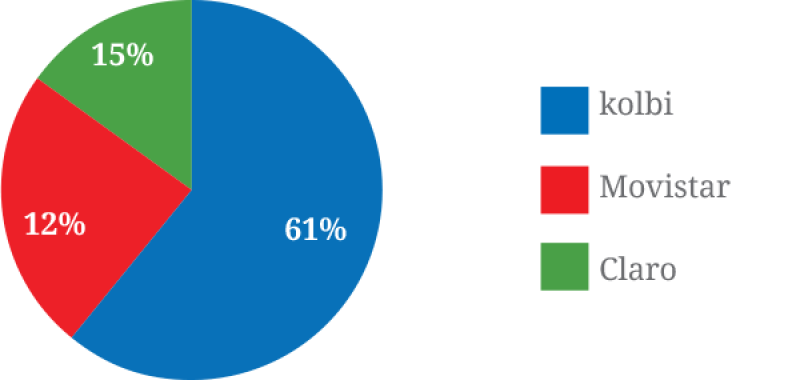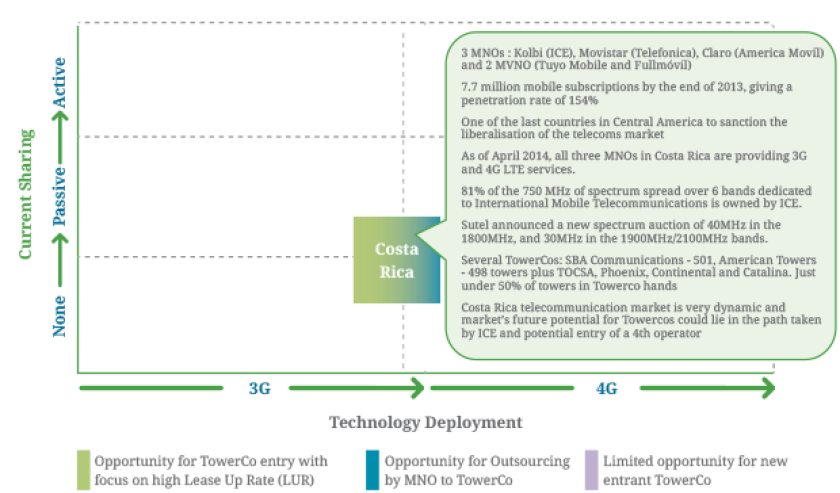Mobile Market Overview
Costa Rica had a population of 5.0mn people and 7.7mn mobile subscriptions by the end of 2014, giving a penetration rate of 154% - one of the highest in Central America, alongside Panama and El Salvador. Around 83% of subscribers had a pre-paid account.
There are three Mobile Network Operators (MNOs) serving the Costa Rica market, of which kolbi (ICE) was the clear market leader with 4.7mn subscriptions– 61% market share (See figure 1), significantly ahead of Movistar (Telefónica) with 1.9mn subscriptions and Claro (América Móvil) which had 1.1mn. Movistar in particular has been showing rapid growth over the last two years – adding 1.4mn subscribers in the period, putting it clearly in second place in terms of market share. In contrast Claro’s subscriber base actually declined over 2014.
Mobile subscriptions- market share

Key mobile developments
Costa Rica was one of the last countries in Latin America to sanction the liberalisation of the telecoms market, in 2008. This marked the end of the national operator Grupo ICE’s 46 year monopoly and lead to the creation of a new regulatory body, the Superintendencia de Telecomunicaciones (SUTEL), a move intended to promote and stimulate market competition.
After market liberalisation, the number of subscriptions started to increase dramatically. Rapid subscription growth continued until 2010 and has since slowly tapered off.
In 2010 a spectrum auction took place, and in Q4 2011 two new players – Movistar and Claro – launched services. While three concessions were available, only Movistar and Claro made bids for spectrum - with Movistar offering US$95mn for 60MHz of spectrum in the 850, 1800 and 2100 bands, and Claro offering US$75mn for 60MHz spectrum in the 1800 and 2100 bands.
kolbi has also since signed agreements with the two mobile virtual network operators (MVNOs), Tuyo Mobile and Fullmóvil, which together account for 2% of subscriptions.

In May 2015 Sutel has sanctioned ICE for ‘a very serious infringement’ of anti-monopoly rules in the mobile market in 2011-2012, with its subsidiary Kolbi handed a fine of CRC2.158bn (US$3.97mn).
The company was accused of margin squeezing through its pre-paid ‘Chip Extremo’ promotion, which offered free bonus minutes. According to Sutel, the service was offered in November and December 2011 and October and November 2012 and had an anti-competitive impact on the basis that ‘if competitors had wanted to match the offer within the prescribed period, [they] would have incurred economic losses.’ This was particularly telling as Movistar and Claro were new to the market at the time.
All three MNOs in Costa Rica are now providing both 3G and 4G LTE services. Kolbi is providing GSM on the 900 MHz/1800 MHz band, 3G on the 850 MHz band and the 4G at 2.6 GHz. Movistar and Claro are providing 3G services respectively on 850/2100 MHz bands and at 2100 MHz and 4G services on the 1800 MHz band. Costa Rica has 750 MHz of spectrum spread over six bands dedicated to International Mobile Telecommunications with 81% of which is owned by ICE.
In late 2014 all three operators stated plans to continue expanding LTE coverage. El Financiero reported that Claro, which currently serves the western and northern areas of San José, as well as Alajuela and Heredia, plans to triple the size of its footprint by 2016, whilst Movistar has said that it plans to expand ‘rapidly’ to serve the areas of the country it does not already cover. Kolbi, meanwhile, offered LTE in 357 locations at the time, and stated plans to expand further. Indeed in December 2014 it announced it had completed the deployment of 354 Long Term Evolution (LTE) base stations. The new towers were deployed in the San José greater metropolitan area as well as ‘provinces and distant places, not just where people can afford [the higher-priced 4G services]’ – according to Jaime Palermo, ICE’s manager for telecoms.
Internet access in Costa Rica is dominated by mobile services which account for 88% of all access. This is principally due to ICE having focused investments on mobile network infrastructure at the expense of fixed line development (indeed fixed line penetration has been in steady decline). The director of GSMA Latin America commented in late 2014 that smartphones were used by 27% of all mobile customers in Costa Rica – and accounted for 95% of mobile data traffic.
To stimulate the development of data services, the government recently announced a new spectrum auction of 40MHz in the 1800MHz, and 30MHz in the 1900MHz/2100MHz bands. kolbi declared it has no intention of bidding, but the previous calls to auction more spectrum by Movistar and Claro could indicate their interest in increasing their spectrum. It is also important to note that this auction is not restricted to existing local market players and the potential entry of a fourth player is possible.
The Tower sharing market
While law 8660 article 77 clearly describes Sutel’s competences to promote infrastructure sharing or act ex officio to resolve differences or disputes, there is currently little sign of regulatory activity to drive sharing.
Operators have heavily invested in infrastructure to expand their coverage and have been expressing their frustration at the difficulty of building new infrastructure when faced with current legal structures - which give local communities the legal autonomy to establish their own conditions when companies request permits to install telecom towers.
Spectrum band allocation represents another issue for Claro and Movistar, regarding the expansion of their footprint, as the spectrum allotted requires more towers to achieve an equivalent coverage to networks operating on lower frequencies - which provide better cellular penetration and coverage with fewer cell sites.
Nevertheless, in order to sustain their development while being competitive, Claro and Movistar have already been using the services of TowerCos to build and manage towers in Costa Rica.
In 2011, Global Tower Partners purchased 250 towers from Centennial Towers in Costa Rica. GTP was later acquired by American Towers - which owns a total of 498 towers in Costa Rica at present. Alongside AMT, several other TowerCos are present in the market: SBA Communications, which manages a portfolio of 501 towers, TOCSA with 105 towers, Phoenix Tower, Continental Towers and new player Catalina Inc. All in all there are approximately 2,800 towers in the country with just under half of them in towerco hands (the rest being owned by kolbi and Claro).
Conclusions
Since its liberalisation, the Costa Rica telecommunication market has been very dynamic, driven by the entrance of key new players which are part of groups with extensive experience in Latin American markets – Movistar and Claro. The pace of technological development has also been rapid in the last two to three years, with LTE launched in 2013 – putting Costa Rica close to the 4G forefront in Latin America. Mobile penetration is high as well as the number of post-paid subscribers, which could help to drive the take-up of mobile data services and the infrastructure required to enable them.
Such market conditions help to explain why several leading TowerCos are already active in this market and why new players have recently entered. One key to the market’s future potential for TowerCos lies in the path taken by ICE – given it dominates the market with 61% market share. Any moves by the regulator to address its dominance, including requirements to release or share infrastructure, or any strategic moves in that direction by ICE itself, will significantly boost the potential for TowerCos. The potential entry of another mobile operator could also create opportunities in due course.

